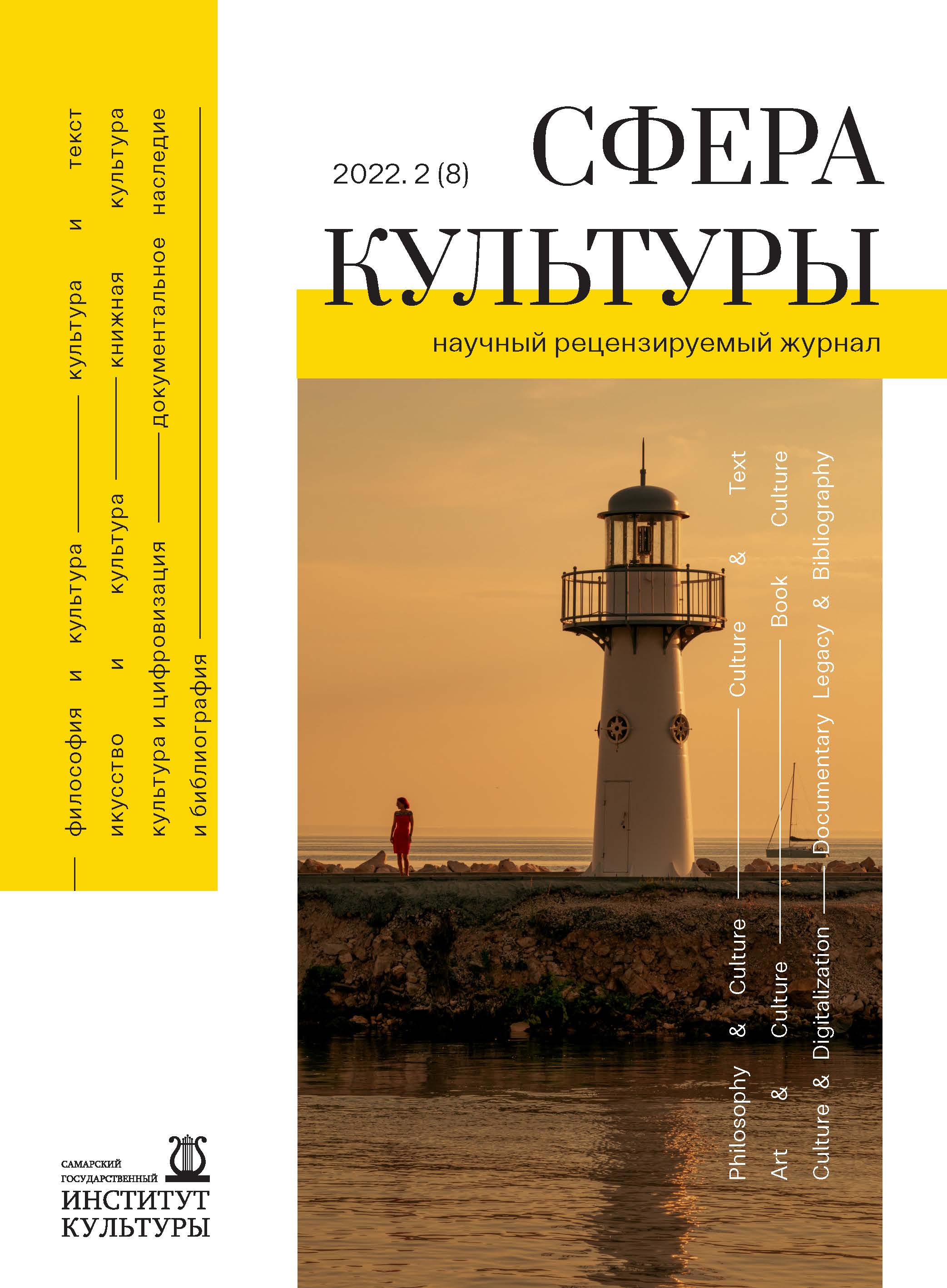Том 3, № 2 (2022)
- Год: 2022
- Выпуск опубликован: 25.09.2022
- Статей: 11
- URL: https://journals.eco-vector.com/2713-301X/issue/view/5590
Весь выпуск
Культура и философия
Утилитаризм в культурно-философском дискурсе современности
Аннотация
В исследовании анализируется амбивалентность утилитаризма в культурно-философском дискурсе. Позитивность данной теории усматривается в её способности стимулировать продуктивное совместное творчество и выступать в качестве действенного средства воспроизводства современной культуры. Негативность утилитаризма обнаруживается в толковании пользы как ценности в субъективно-прагматичной плоскости, что открывает неограниченные возможности манипулирования ценностными представлениями человека.
 13-21
13-21


Культура и текст
Проблемы метаповествования в пьесе и кинофильме Т. Стоппарда «Розенкранц и Гильденстерн мертвы»
Аннотация
В статье анализируются пьеса и кинофильм Тома Стоппарда «Розенкранц и Гильденстерн мертвы» как метатексты на различных уровнях их организации. Для анализа применяются структурно-семиотический и нарратологический методы исследования. Показывается специфика работы с драматургическими претекстами кинофильма, переосмысленными в рамках иной семиотической системы, в которой значимыми являются: кадр, звук, монтаж, граница кадра. Особое внимание акцентируется на теоретическом обосновании жанра «метакино» и анализе кинофильма с этой точки зрения. Авторы статьи определяют, как в пьесе и в кинофильме раскрывается центральный вопрос о соотношении жизни и искусства, анализируют принципы взаимодействия автора, текста и читателя. В выводах отмечается, что кинотекст строится как сложная кинематографическая игра со множеством смысловых слоев. Многочисленные оппозиции (условный/реальный миры, традиционализм/неклассическая парадигма художественности), а также использование приема «текст в тексте» позволяют говорить о границах театрального и киноискусства.
 25-37
25-37


Культура и искусство
Исторический концерт как проявление сотворческого феномена просветительства (на примере «Маленьких концертов» Ш.-В. Алькана)
Аннотация
Традиция исторических концертов, представлявших собой форму популяризации музыкального наследия прошлого, восходит ко второй четверти XIX века. В статье описывается зарождение данного явления во Франции (Ф.Ж. Фетис), Германии (И. Мошелес), Англии (Э. Пауэр) и России (А.Г. Рубинштейн, С.В. Смоленский, С.Н. Василенко, М.Ф. Гнесин). На основе критических публикаций в периодическом издании «Музыкальное обозрение и парижская музыкальная газета» (Revue et gazette musicale de Paris) рассматривается один из эпизодов творческой биографии выдающегося французского композитора-романтика Ш.-В. Алькана (1813–1888), чей шестилетний цикл «Маленьких концертов» (Petits concerts, 1873–1880) считается уникальным примером музыкального сотворчества.
 41-54
41-54


Арт-пространство современного музея и культурная медиация
Аннотация
Культурная медиация является одной из актуальных музейных практик современности. В статье осмысливаются особенности данного явления, обозначаются перспективы его использования в связи с нормами музейного законодательства, мировой практикой. Приводится информация об отечественных исследованиях, посвященных культурной (арт) медиации, её теоретическим и методическим аспектам. Рассматривается опыт внедрения методов культурной медиации в музейных учреждениях Самары (на примере выставок в галерее «Нулевая комната», Самарском литературном музее и Музее модерна).
 55-64
55-64


Особенности стенных росписей храмов Углича второй половины XVIII – первой половины XIX века
Аннотация
Церкви и соборы, возведённые в г. Угличе во второй половине XVIII – первой половине XIX в., получили статус памятников зодчества сравнительно поздно, поэтому росписи, выполненные на их стенах, в значительной части оказались утрачены. В исследовании приводится краткий обзор истории храмовых построек города. Автор доказывает, что художники расписывали их стены в строгом соответствии с древними канонами, но на западный академический манер. Оцениваются дальнейшие перспективы изучения стенных росписей храмов Углича, созданных в обозначенный период.
 65-76
65-76


Русский сакральный стиль в миниатюрах лицевого летописного свода Ивана Грозного
Аннотация
Лицевой летописный свод Ивана Грозного – уникальное явление русской и мировой художественной культуры. Документальный памятник, включающий 10 рукописных томов и около 10 тысяч листов текста, содержит более 17,7 тысяч миниатюр. В статье доказывается, что структура, расположение и манера исполнения иллюстраций Свода выражают метафизические принципы русской цивилизации: многомерность, соборность и отстраненность. Особенности русского сакрального стиля книжной миниатюры, его самобытность формировались в результате диалога Западной и Византийской эстетических традиций.
 77-87
77-87


Книжная культура
Современная библиопсихология в контексте наследия Н.А. Рубакина
Аннотация
Выдающийся русский просветитель Н.А. Рубакин оставил богатое научное наследие, связанное с изучением чтения, психологическими и педагогическими аспектами данного процесса. В статье рассматриваются основные теоретические положения библиопсихологии, показана востребованность данной сферы науки и практики для современных библиотек. Автор обозначает перспективы развития библиотечной психологии и библиотечной педагогики в условиях цифровизации чтения, доказывает, что предложения о переименовании библиопсихологии в ноокоммуникологию несостоятельны.
 91-100
91-100


Состояние библиотек Балтийского флота в первые годы советской власти (по материалам РГА ВМФ)
Аннотация
Успех большевистской пропаганды среди нижних чинов Российского императорского флота во многом был обусловлен бездействием или недостаточно активной работой официальных органов, ответственных за воспитательную работу. Учитывая ошибки предшественников, советская власть с первых своих дней уделяла очень большое внимание агитации и пропаганде в вооруженных силах. В статье рассматривается деятельность военно-морских библиотек в контексте воспитательной работы на Балтийском флоте в 1918–1924 годах.
 101-110
101-110


Культура и цифровизация
Культурная политика в сфере стимулирования читательской активности молодежи: приоритеты цифровой эпохи
Аннотация
Рассматриваются особенности коммуникативного поведения и ценностей молодых людей, значимые для активизации их читательской деятельности. Использованы эмпирические материалы исследования «Чтение студенческой молодежи Южного Урала: стимулы и практики формирования интеллектуального ресурса региона в век цифровых технологий» (2021). Обозначены приоритеты культурной политики в деятельности по стимулированию читательской активности интернет-ориентированной аудитории. Обоснована необходимость мониторинга различных проявлений читательской активности в институциональной сфере, прежде всего – в сетевом пространстве, с целью выявления особенностей читательских практик, порожденных реалиями цифровой эпохи, и гармонизации виртуального и реального миров.
 113-128
113-128


Документальное наследие и библиография
Русско-немецкие перекрестки: «Издательство И.П. Ладыжникова» в одном скетче
Аннотация
Публикация вводит в научный оборот документ, выявленный в Международном институте социальной истории (IISH) в Амстердаме в фонде Б.Н. Рубинштейна. Дружеский скетч по поводу празднования в Берлине 15-летия «Издательства И.П. Ладыжникова» описывает некоторые эпизоды работы крупнейшей коммерческой фирмы русского зарубежья, тесно связанной с нелегальной деятельностью большевистской фракции РСДРП. Автор приводит обзор истории «Издательства И.П. Ладыжникова», а также факты, свидетельствующие о достоверности данного скетча как исторического источника.
 131-143
131-143


Приложение к статье Е.С. Богдановой «Спецэффекты советского кино: метод дорисовки» (окончание).
 144-151
144-151












